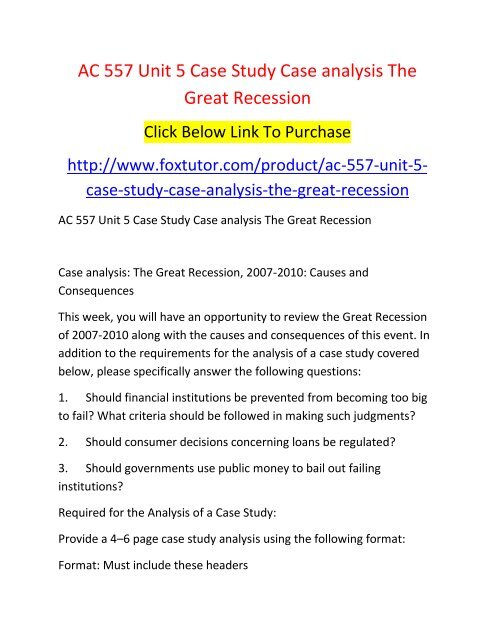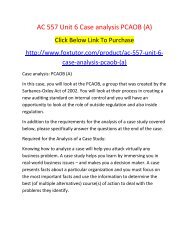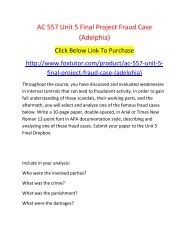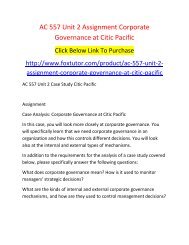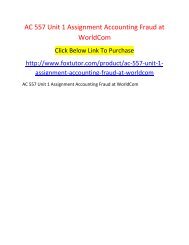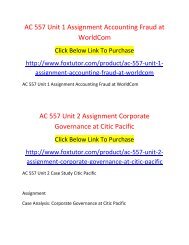AC 557 Unit 5 Case Study Case analysis The Great Recession
You also want an ePaper? Increase the reach of your titles
YUMPU automatically turns print PDFs into web optimized ePapers that Google loves.
<strong>AC</strong> <strong>557</strong> <strong>Unit</strong> 5 <strong>Case</strong> <strong>Study</strong> <strong>Case</strong> <strong>analysis</strong> <strong>The</strong><br />
<strong>Great</strong> <strong>Recession</strong><br />
Click Below Link To Purchase<br />
http://www.foxtutor.com/product/ac-<strong>557</strong>-unit-5-<br />
case-study-case-<strong>analysis</strong>-the-great-recession<br />
<strong>AC</strong> <strong>557</strong> <strong>Unit</strong> 5 <strong>Case</strong> <strong>Study</strong> <strong>Case</strong> <strong>analysis</strong> <strong>The</strong> <strong>Great</strong> <strong>Recession</strong><br />
<strong>Case</strong> <strong>analysis</strong>: <strong>The</strong> <strong>Great</strong> <strong>Recession</strong>, 2007-2010: Causes and<br />
Consequences<br />
This week, you will have an opportunity to review the <strong>Great</strong> <strong>Recession</strong><br />
of 2007-2010 along with the causes and consequences of this event. In<br />
addition to the requirements for the <strong>analysis</strong> of a case study covered<br />
below, please specifically answer the following questions:<br />
1. Should financial institutions be prevented from becoming too big<br />
to fail? What criteria should be followed in making such judgments?<br />
2. Should consumer decisions concerning loans be regulated?<br />
3. Should governments use public money to bail out failing<br />
institutions?<br />
Required for the Analysis of a <strong>Case</strong> <strong>Study</strong>:<br />
Provide a 4–6 page case study <strong>analysis</strong> using the following format:<br />
Format: Must include these headers
1. Title page<br />
2. Company and Situation: Describe the Company and Situation<br />
· To begin your case study <strong>analysis</strong>, discuss the critical incidents<br />
that have contributed to the current position of the company. Here you<br />
must identify the most important facts surrounding the case.<br />
· Does the problem or challenge facing the company come from a<br />
changing environment, new opportunity, a declining market share, or<br />
inefficient internal or external business processes?<br />
3. Strengths, Weaknesses and Alternatives: Identify Strengths and<br />
Weaknesses as well as Alternatives<br />
· Examine the value creation functions of the company and specify<br />
alternative courses of action.<br />
· List the courses of action the company can take to solve its<br />
problem or meet the challenge it faces. What changes to organizational<br />
processes would be required by each alternative? What management<br />
policy would be required to implement each alternative?Remember,<br />
there is a difference between what an organization “should do” and<br />
what that organization actually “can do.” Some solutions are too<br />
expensive or operationally difficult to implement, and you should avoid<br />
solutions that are beyond the organization’s resources. Important:<br />
Identify the constraints that will limit the solutions available. Is each<br />
alternative executable given these constraints?<br />
4. Implementations: Analyze ImplementationsThis portion of the<br />
case study <strong>analysis</strong> requires that you identify and analyze the structure<br />
and control systems that the company is using to implement its
usiness strategies. Evaluate organizational change, levels of hierarchy,<br />
employee rewards, conflicts, and other issues that are important to the<br />
company you are analyzing.<br />
5. Recommendations: Make Recommendations<strong>The</strong> final part of your<br />
case study <strong>analysis</strong> should include your recommendations for the<br />
company. Every recommendation you make should be based on and<br />
supported by the context of your case study <strong>analysis</strong>, i.e., what you<br />
have already written.<br />
6. Additional Questions: Answer the additional questions as shown<br />
below. Each question should be placed in bold as a header:<br />
1. Should financial institutions be prevented from becoming too big<br />
to fail? What criteria should be followed in making such judgments?<br />
2. Should consumer decisions concerning loans be regulated?<br />
3. Should governments use public money to bail out failing<br />
institutions?<br />
7. References: Reference page<br />
Access the case study template formatted in APA.<br />
<strong>The</strong> case <strong>analysis</strong> should be a minimum of four pages, double-spaced.<br />
Check for correct spelling, grammar, punctuation, mechanics, and<br />
usage. Citations should use APA style.<br />
Your <strong>analysis</strong> of this case and your written submission should reflect an<br />
understanding of the critical issues of the case; integrate the material<br />
covered in the text and present concise and well-reasoned justifications<br />
for the stance that you take.
Make sure your document includes:<br />
· Your name<br />
· Date<br />
· Course name and section number<br />
· <strong>Unit</strong> number<br />
· <strong>Case</strong> name<br />
· Page numbers


